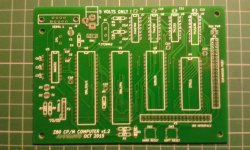Stephen Scutt
Member
- Joined
- Sep 9, 2015
- Messages
- 22
Hi everyone. I recently bought a PCB on Ebay which is a Z80 SBC based upon Grant Searle's Z80 CP/M breadboard project: http://searle.hostei.com/grant/cpm/index.html

I would like to know if anyone in the UK (or anywhere really) has a Z80 SIO/1 chip and a 62128 SRAM chip (32 pin DIP) they could sell me for a reasonable price or donate towards the project..
If you do please send a message.
Any help seriously appreciated.
Thanks,
Steve.S

I would like to know if anyone in the UK (or anywhere really) has a Z80 SIO/1 chip and a 62128 SRAM chip (32 pin DIP) they could sell me for a reasonable price or donate towards the project..
If you do please send a message.
Any help seriously appreciated.
Thanks,
Steve.S
